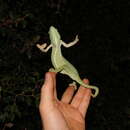tr
kırıntılardaki isimler


Least Concern
Medium to large lizard, largest Egyptian specimen with a SVL of 190 mm (total length of 340 mm). Occipital flap absent, casque low; body scales small, granular, more or less uniform. Limbs rather long; a tarsal spur present in males. Basic color green with small dark spots with a ventral white line from throat to vent. Color highly variable according to season and disposition. In breeding males color can be light sky-blue, with green and yellow bands. Sick or injured animals can be brown or gray.
Nile Delta and Valley. Most widespread in the northern parts of the Delta, between Alexandria and Damietta, south to El Mansoura. One road casualty was found in Wadi El Natrun. Distribution in the Nile Valley is not well known. Recorded from Wadi Haifa, Dabarosa (both in Sudan), El Deir, and Krosko (Anderson 1898, Flower 1933, Smith et al. 1998), localities now inundated by the waters of Lake Nasser. A record of several C. chamaeleon from near the Saqqara Pyramid (Meininger and Atta 1994) is probably referable to C. africanus. The species is also known from a small island in the Nile opposite El Saff . C. africanus is likely to be widespread in the Nile Valley, but is under-documented due to its cryptic coloration and habits. Anderson (1898) speculated that the origin of the population of C. africanus in lower Egypt might be due to introduction by human agency. However, the mention by the same author of old reports of "Chameleons" being common in and around Cairo orchards (most likely of this species) in the 14fh and 15th century A.D., and the sporadic occurrence of the species along the Nile Valley (which links northern and southern populations), in addition to the morphological differences between Egyptian and sub-Saharan populations, all indicate that the species' northern extension is a natural one.
Egypt, Sudan, west along the Sahelian belt to Mali. A small population recently discovered in Greece (Bohme et al. 1998) was probably introduced from Egypt, possibly in historical times, or perhaps in more recent years.
It inhabits cultivated areas, where it is found in orchards, often near or at the margin of wetland. Seens to prefer short dense trees and reeds. However, near El Saff it has been observed high on large mango trees near the Nile.
Fairly common in the northern Delta. On 8 September 1991 seven fresh casualties were found along a 20-km stretch of road near Rosetta. Fairly large numbers are collected for the pet trade. Chameleons are popular pet animals in trade. The impact of collection on this species is probably not significant yet, but numbers collected appear to be larger than in the past. In Egypt it is Vulnerable.